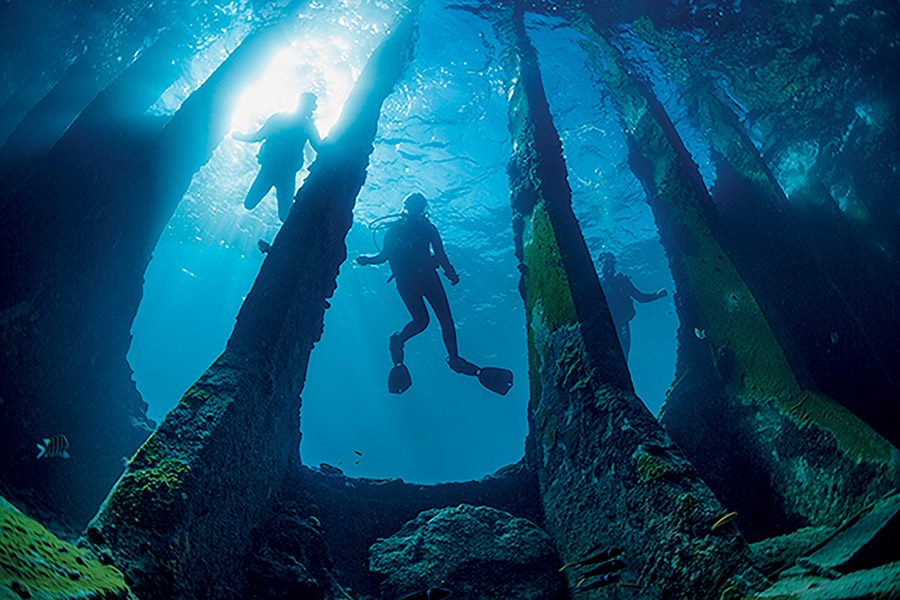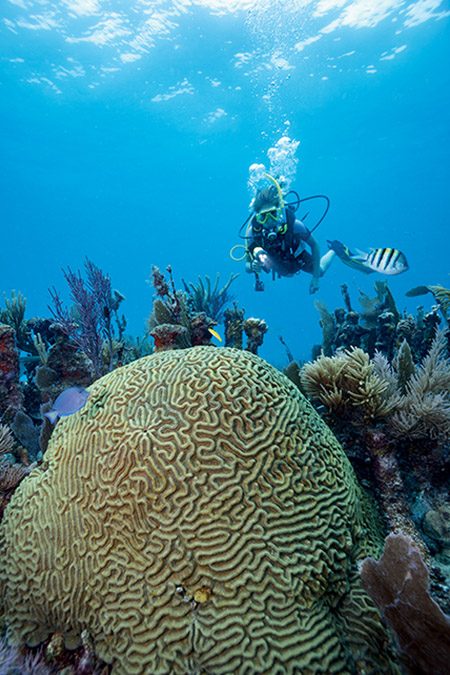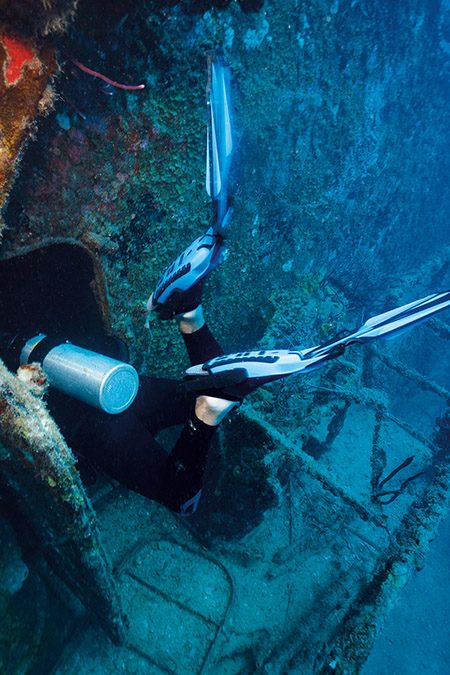Most divers’ love of the sport stems from a drive to explore a foreign environment. With exploration must come the ability to navigate. Nowhere else on Earth can one become more lost than in a liquid, while simultaneously requiring constant individual concentration on safety techniques, breathing gas, buoyancy, horizontal trim, depth, and time.
When it comes to safety, many divers overlook navigation as a crucial tool for their survival. The ability to effectively and efficiently navigate underwater directly affects every aspect of a dive. It’s all too common to see a pair of divers go through a complete gear check and dive plan only to set off on their dive and quickly become lost. Divers who continually bounce to the surface to get their bearings can increase their risk for pressure-related problems such as squeezes, reverse blocks, and expansion injuries.
Orienting yourself underwater is one of the most difficult obstacles to overcome to make the dive a safe and enjoyable one. Different underwater environments and activities warrant different navigation strategies. Whether the dive is guided or not, every diver should be able to successfully navigate throughout the duration of the dive and find their way back to their entry point.
Open-Water Environments
Skilled divers use a combination of compass and natural navigation in conjunction with cognitive mapping and an understanding of underwater currents. Natural or environmental navigation, sometimes referred to as pilotage, relies on visually referencing external cues.
Divers use underwater landmarks to achieve their objective by going from one spot to another in the form of point-to-point navigation. It is best applied on sites with fair to good visibility and distinguishing natural features such as coral ledges, rock formations, or distinct vegetation zones. Most dive sites have at least one prominent natural or artificial feature.
Recognize checkpoints and space them out equally. Too far apart can cause you to wander off course, but too many points are hard to remember. Have a thorough mental picture of where you’ve been so you can visualize it and trace it backward. Remember that features may look significantly different from the opposite side. Looking back at each checkpoint after passing it will help you identify it from your return direction.
As divers move through the water on a compass heading, currents will invariably move them off course. A current may flow from a different direction at the bottom from what can be observed on the surface. A diver might also enter an area where a current suddenly occurs or changes direction. When a diver obtains their best determination of the direction of an underwater current and its speed, they can anticipate the effect it will have on their navigational course and adjust for it accordingly. A cross or angled current requires a diver to maintain their compass heading and then adjust their kick direction into the current so their net movement is in their intended direction of travel.

Limited-Visibility Environments
Visibility drastically affects a diver’s ability to navigate underwater. Site conditions in some locations can change tremendously between visits, and limited visibility may make natural navigation techniques impossible. A complete loss of orientation can cause uneasiness or panic in even the most experienced divers, resulting in uncontrolled ascents or descents, increased air consumption, and buddy separation.
Limited visibility also subconsciously hampers your progress underwater, reducing speed and kick cycles as you anticipate feeling the area in front of you to avoid colliding with a submerged object. It is possible to become disoriented enough in a limited-visibility environment to not recognize which direction is up or down, even when clinging to a vertical line.
Exhalation bubbles always rise, but finding which way is up by your exhaust is hard when a swift current pulls away your bubbles horizontally and out of sight before you can see them ascend. Gently tilting your head to the side and partially flooding your mask will give you a constant reminder of where the surface is regardless of your position, as water in your mask will always settle at the bottom.
If you dive long enough, there may come a time when you will be forced to rely solely on your gear for navigation. In these moments your skills practice, training, and preparation are crucial to successfully completing the dive. You will have to trust that your equipment works, just as you do with your regulator, and that your practiced techniques are solid and that you can successfully navigate to your intended destination.
In that dark space where you are enveloped by particles and can see less than a foot in front of you, you may look around and intuitively try to trend in the direction you feel you should go. Understand that weightlessness has already disrupted your sense of equilibrium and that visual sensory deprivation has compromised your sense of spatial orientation. The sense of direction you possess on land is not applicable here. Shut down those feelings and instead trust your equipment and your skills.


Overhead Environments
Overhead environments are confined spaces where a diver’s free ascent to the surface is not possible. Never enter an overhead environment without proper training, regardless of how simple you perceive navigating the enclosure to be.
Many divers consider caves to be the most complex overhead environments to navigate. Some caves have tangible and established flow patterns that allow divers to orient themselves. Others lack strong flow and require the diver’s keen attention to features of the cave, such as geological composition or sediment characteristics as a supplement to their guideline.
Proper cave training is imperative for navigating these environments — incorrectly marking or having a false understanding of line markers can confuse and imperil yourself and others. Cave lines are marked differently depending on geographical location, and impetuously following lines and markers based on assumed meaning is a quick way to a slow death.
Navigating the internal structure of a shipwreck can be just as difficult as cave diving. Wrecks can rest on the bottom in every possible orientation, influenced by the bottom topography and the elements that led to the ship’s sinking. In even the clearest visibility, navigating inside a wreck with the floors, walls, and doorways at unusual angles can be dizzying.
Using a compass on top of or inside a steel wreck may be difficult or impossible — metal present in the components of a wreck can throw off the needle and give divers an erroneous reading. Wooden shipwrecks can also affect a compass if taking a reading too close to metal spikes, nails, or ferrous material present in submerged cargo.
As a wreck continues to deteriorate, it creates a myriad of obstructions and entrapment hazards, such as collapsed interior walls and dangling cables and wires. A diver can accidentally ascend or descend to a different deck level, finding themselves in a new passageway with no discernable way forward or back.
Diving in ice-covered water has its own navigational concerns. Depending on proximity to the magnetic poles in both polar regions, an analog compass may be rendered inoperable, and most digital dive compasses that still rely on magnetic principles will also be negatively affected. Extremely cold water also impacts a dive computer’s battery life.
Ice cover diffuses surface light, and sunlight becomes unavailable to assist divers as a positioning reference at depth for navigational aid. Ice cover also hinders wave action and the creation of ripple patterns on the bottom to use for natural navigation.
Silt-outs causing zero-visibility conditions can occur inside caves or wrecks. When diving overhead environments, plan for and expect silt-outs rather than fearing or trying to pray them away. The safest, best navigation practice is to never enter an overhead environment without a direct line that leads back to the point of entry, allowing you to safely return to the surface. Line laying and the use of wreck reels is a skill in and of itself. Divers who struggle with the basics of buoyancy and trim could become entangled in existing lines as well as their own.
Successful navigation begins before a diver enters the water and depends first and foremost on one’s ability to master the basic fundamental skills of diving. No magic pill or piece of dive gear will act as a shortcut and allow you to overcome a poor skills base.
Successful underwater navigation is directly linked to diver safety. Mastering navigation techniques will assist divers in conserving energy and air, limiting the need to surface, and will offer divers the maximum exploration time allotted in their dive plan.
Whichever navigation techniques you follow, use them from the start of the dive until it ends. Failing to navigate to a known location or becoming lost underwater is an easy way to waste a dive and deplete your finite supply of air at depth.
© Alert Diver — Q2 2024